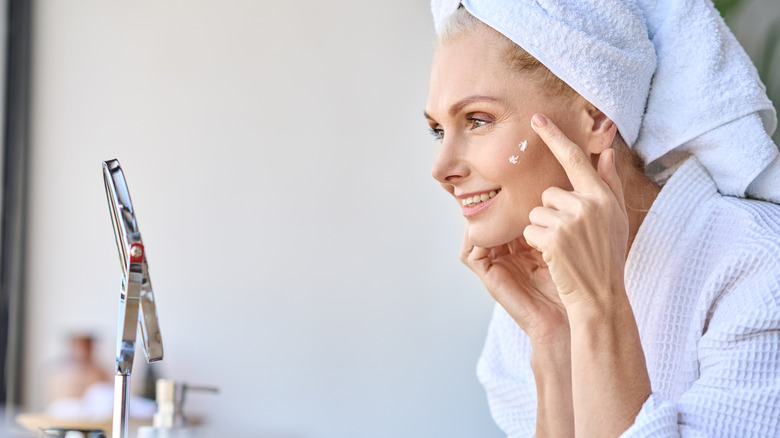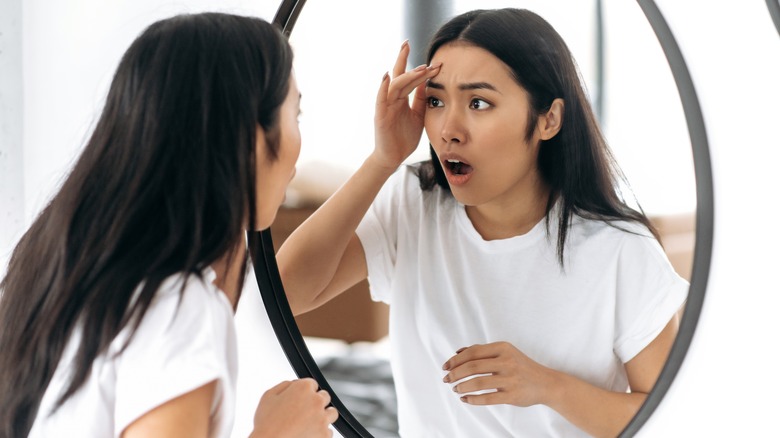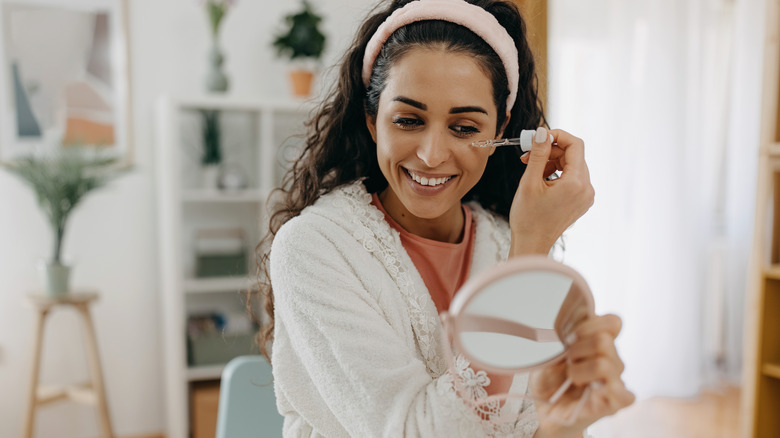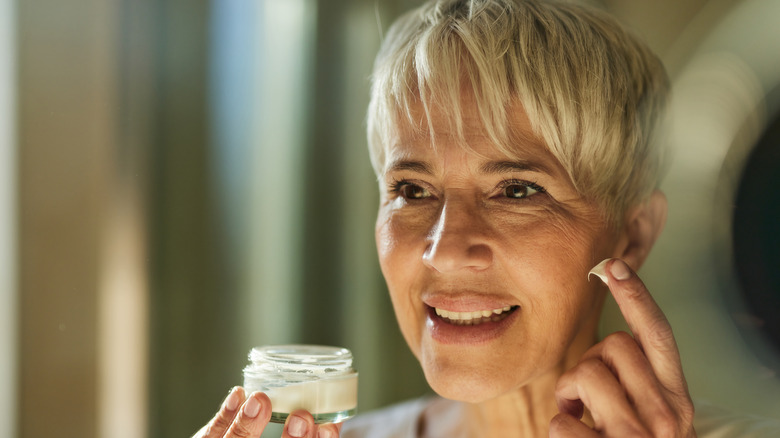Argireline: What To Know About The Wrinkle-Reducing Skincare Ingredient
We may receive a commission on purchases made from links.
Friendly reminder: Wrinkles are a totally normal and natural part of getting older. There's no medical need to smooth or eliminate them from your face, and they pose no harm to you or the health of your skin. However, if smile lines and crow's feet are getting you down, there are plenty of methods to prevent and treat them, from DIY creams to surgical procedures.
One wrinkle-fighting solution that might not be on your radar (until now, that is) is Argireline. This tricky-to-pronounce term is actually the brand name of a synthetic skincare peptide otherwise known as acetyl hexapeptide-8 and acetyl hexpeptide-3. If that still doesn't ring a bell, you may have seen the ingredient in the TikTok-viral Argireline Solution 10% by skincare brand The Ordinary, commonly referred to as "Botox in a bottle" by SkinTokkers. That nickname might not be a hyperbole — as Dr. Rita Linkner, a board-certified dermatologist and founder of RVL Skincare, told Byrdie, "Everyone is trying to mimic Botox's contenders, and so far, argireline is one of the best contenders."
The ingredient may be promising, but before you try it to soften those forehead creases and 11 lines, make sure you know how it works and the potential downsides.
How Argireline affects the skin
Argireline is often compared to OG anti-wrinkle treatment Botox because, in many ways, they work similarly. "Argireline [...] is a peptide that works by hindering the release of neurotransmitters to activate muscle movements, producing a Botox-like effect," Dr. Jodi LoGerfo, a cosmetic nurse practitioner, explained to Well+Good. "Argireline has also been shown to help encourage the production of collagen, possibly increasing skin tone and firmness." According to the Harvard T.H. Chan School of Public Health, collagen production decreases with age, and existing collagen can break down over time, creating wrinkles and other signs of aging.
So just how powerful are Argireline's movement-limiting, collagen-boosting powers? One 2013 study published in the "Journal of Cosmetic and Laser Therapy" found a 49% reduction in wrinkles, particularly around the eyes, among participants who used the ingredient twice a day for four weeks (other research suggests Argireline is slightly less effective, such as a 2011 trial by Mahidol University, which found a 30% reduction in wrinkles). Another 2013 study also published in the "Journal of Cosmetic and Laser Therapy" concluded that Argireline can improve the structure of aging skin by increasing certain types of collagen fibers.
Keep in mind, though, that the peptide might not work on all trouble spots. For example, The Ordinary's Argireline Solution 10% only targets dynamic wrinkles (the lines that form from repeated facial movements and expressions) rather than static wrinkles (deep wrinkles caused by a lack of elasticity).
Are needles required?
If you've steered clear of Botox and fillers because you're afraid of needles, you're in luck. With Argireline, no needle injections are required. That means you don't need a doctor's appointment to start using this wrinkle-softening ingredient. "Argireline is the closest ingredient that we have to Botox in cream," Dr. Joshua Zeichner, director of cosmetic & clinical research in dermatology at Mount Sinai Hospital, shared with Today. You may find it in moisturizers and eye creams formulated for aging skin, as well as serums meant for all ages.
The product you choose will determine exactly how and when to use it, but to fully reap the benefits of this plumping peptide, it's generally a good idea to apply it to your skin twice a day. And unless you're using it as your go-to moisturizer, you probably won't need to apply an Argireline-rich formula all over your face. Instead, make the product last longer by tapping it only on your fine lines or the areas that wrinkle when you move your face, such as between the eyebrows.
Argireline isn't a miracle ingredient
Argireline may be an effective, needle-free alternative to Botox, but that doesn't mean it's perfect. The ingredient is generally safe and non-irritating on the skin, but the wrong formula may cause side effects. "Argireline can be hard to formulate with, and some companies mix the ingredient with alcohols, which counteract its hydrating function," plastic surgeon and skin expert Dr. Manish Shah revealed to Byrdie. As a result, you might notice dryness or crepey skin – basically the opposite of the smooth, bouncy effect you probably anticipated. Skincare brand Paula's Choice also warns that heavy products are unlikely to penetrate the skin, so if you try Argireline and it doesn't work, switching to a lighter formula containing more water might do the trick.
Even still, don't expect the skincare ingredient to work just as well as its injectable counterpart. "Compared to Botox, argireline's effects are much more subtle," Dr. Rebecca Marcus, a board-certified dermatologist and founder of skincare brand Maei MD, explained to Well+Good. "In addition, Argireline yields a very temporary effect, whereas the effects of Botox can be expected to last around three months." To sum it up, Argireline belongs in your skincare arsenal if you're looking for low-key results and can commit to using it regularly to keep wrinkles and collagen damage at bay.



